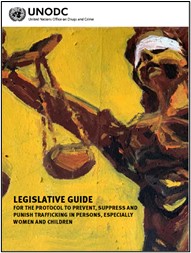- Trafficking in persons is a serious crime that undermines the dignity and liberty of its victims. Every year, thousands of women, men, and children fall into the hands of traffickers, in their own countries and abroad. Almost every country in the world is affected by trafficking, whether as a country of origin, transit or destination for victims. Accurate and complete data on the true extent of trafficking is difficult to collect, including because many instances of trafficking occur clandestinely and are never officially recorded. The number of victims of trafficking in persons recorded each year is, however, rising, which is also a result of improved detection and reporting methods.
- The challenge for all countries is to target the offenders who exploit desperate people and to protect and assist victims of trafficking, many of whom endure unimaginable hardships in their bid for a better life. The Protocol to Prevent, Suppress, and Punish Trafficking in Persons, especially Women and Children [the ‘Trafficking in Persons Protocol’], supplementing the United Nations Convention against Transnational Organized Crime marks the international community’s most comprehensive effort to deal with trafficking in persons in its modern forms. Since its adoption in 2000, the Trafficking in Persons Protocol has spurned significant activities at the local, national and international levels.
- The purpose of the Protocol, as expressly stated in its article 2, are:
- To prevent and combat trafficking in persons, paying particular attention to women and children;
- To protect and assist the victims of such trafficking, with full respect for their human rights, and
- To promote cooperation among States Parties in order to meet those objectives.
- The Trafficking in Persons Protocol is a milestone in the development of international law and overcomes weaknesses in earlier international instruments that were less precise about the meaning of trafficking in persons and not comprehensive enough about the specific actions that must be taken to combat it. Unlike earlier instruments, the Protocol seeks to address trafficking in persons in all its manifestations, regardless of the exploitative purpose, regardless of whether the crime occurred transnationally or not and regardless of the victim’s age and gender. The Protocol nevertheless recognizes that women and children are disproportionately affected by this crime. The Protocol sets out a minimum uniform approach to be taken by all States Parties, and to facilitate international cooperation among them.
A short history of events leading to the enactment of the Trafficking in Persons Protocol
- Throughout the 19th and 20th centuries, a wide range of international instruments emerged which sought to prevent and combat the exploitation of human beings. These instruments address, inter alia, slavery and servitude, the exploitation of prostitution of others, and forced labour, as well as the rights of children and other human rights dimensions associated with exploitation. Often aimed at particular types of offending or specific categories of persons, these instruments did not form a framework to tackle trafficking in persons comprehensively, yet they have helped to shape and explain the scope, vocabulary, and interpretation of the Trafficking in Persons Protocol.
- The origin of the Protocol can be found in a proposal made by the Government of Argentina suggesting the development of a new convention against trafficking in minors. The proposal was discussed in 1997 during the Sixth Session of the Commission on Crime Prevention and Criminal Justice (CCPCJ), the central body within the United Nations (UN) system dealing with criminal justice matters.
- On 9 December 1998, following recommendations by the CCPCJ and the Economic and Social Council (ECOSOC)5, the UN General Assembly established an open-ended intergovernmental Ad Hoc Committee open to all Member States to draft and discuss the main text of a new comprehensive international convention against transnational organized crime along with three additional international legal instruments (later referred to as Protocols), including one instrument on trafficking in women and children.
- Between January 1999 and October 2000, the Ad Hoc Committee held 11 sessions at the United Nations in Vienna, Austria to discuss and finalise the text of the Convention and the three supplementing Protocols. At the first session, the United States introduced the draft text for a “Protocol to Combat International Trafficking in Women and Children7” and Argentina for “an agreement on the prevention, suppression and punishment of international trafficking in women and children.8” These were combined and submitted as one draft at the second session of the Ad Hoc Committee in March 19999. Following a resolution by the UN General Assembly, the scope of this additional instrument was expanded to address trafficking in all persons, albeit with special attention to women and children who were believed to be especially vulnerable to this crime.
- Consultations on the Convention against Transnational Organized Crime, the Trafficking in Person Protocol, and the Protocol against the Smuggling of Migrants by Land, Sea and Air concluded at the 11th session in October 2001. The final text of the Convention and Protocols was endorsed by the United Nations General Assembly on 15 November 2000.
- The two Protocols, along with the Convention against Transnational Organized Crime, were opened for signature on 12 December 2000 at a high-level conference held in Palermo, Italy; for this reason, these instruments are sometimes referred to as the ‘Palermo Convention’ or ‘Palermo Protocols’. A third protocol, the Protocol against the Illicit Manufacturing of and Trafficking in Firearms, Their Parts and Components and Ammunition was opened for signature on 31 May 2001.
- The Trafficking in Persons Protocol entered into force on 25 December 2003, 90 days after the fortieth instrument of ratification, acceptance, approval or accession.

